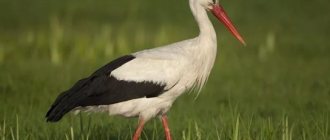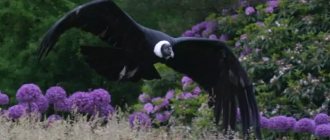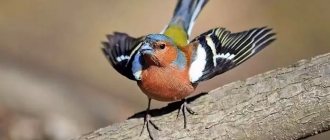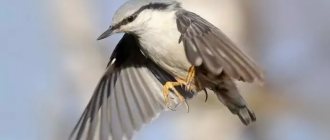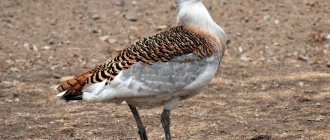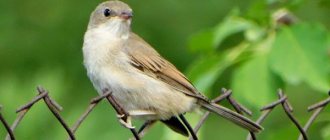The Robin or Robin is a common bird species in Europe and often visits orchards. The bird lives alone outside the breeding season, in winter it moves to people's residences and begs for bread crumbs at doors. Robins consume insects, worms, fruits, and seeds. Sung at dawn, as soon as spring begins, the melodic song enchants, even if it wakes you up early in the morning!
This species stays for the winter or migrates, depending on the region of residence. In spring, the robin builds a nest among vegetation, hiding it in ivy, hedges or dense foliage of a bush. It is a territorial bird that defends its nesting territory from other species and even from other robins. The battles are brutal and sometimes end in the death of one fighter.
Physical characteristics of robins:
- body length 14 cm;
- wingspan 20-22 cm;
- weight 15-20 g.
The species lives in nature for up to 10 years.
Description of the robin's appearance
This bird is interesting to watch. Females and males are similar. The crown, back of the head and upper body, including the wings and tail, are soft brown. Sometimes a not clearly defined black stripe is visible on the wing.
The head, throat and chest are bright red-orange, edged with gray feathers, except for the forehead. The underparts are whitish, the sides are pale reddish brown.
The beak is dark. The eyes are dark brown. Thin legs are pinkish-brown.
Juveniles are generally brown. The underparts are paler, with mottled beige or pale brown spots. Red-orange feathers will appear only after the first moult, after about two months.
Kinds
The robin belongs to the order Passeriformes, the flycatcher family. There are several subspecies of robins, which you can learn about below. Javan mountain robin - lives on the island of Java, Indonesia, Asia Minor. The bird leads a sedentary lifestyle, due to the lack of the need to carry out winter migration. In the colors of this species, brighter colors predominate. In general, the further south a bird lives, the brighter its coloring.
Java Robin
It is 16 cm in length and 15-16 grams in body weight. Nests near water bodies.
Blue-blue mountain robin
This is a very colorful, bright bird. Body length 15-16 cm, weight 16-17 grams. The plumage is dominated by blue and cyan colors, which makes the bird look like a parrot. Inhabits Africa, Asia, Indonesia.
White-tailed mountain robin
It differs from previous species by the presence of white coloring in the tail area. Lives in Siberia, the Caucasus. The dimensions are similar to previous types.
Black-throated Robin or Ryukyu Nightingale
Lives in Japan, Taiwan, on the Ryukyu Island, in the South China Sea.
A characteristic feature of this subspecies of birds is the black plumage on the head and chest. The Ryukyu nightingale has an excellent voice. It nests in forested areas.
Japanese Robin
Inhabits the Japanese islands and the Izu archipelago. It also lives in Russia on Sakhalin Island and the southern Kuril Islands. By the way, the bird is included in the Red Book of Sakhalin and is under the protection of the Kurilsky Nature Reserve.
The body length of this bird is 14 cm, weight is 16 grams. In this species, sexual dimorphism is well expressed. The male is dark brown in color, the abdomen is blue, and the female is pale brown in color; her color scheme does not include black and blue.
The Japanese Robin has two more subspecies. Their differences are only in placement.
- The first subspecies lives on Sakhalin Island, northern Japan, southern China, and also on Rishiri Island.
- The second subspecies inhabits the islands: Yakushima, Tanegashima, Izu Archipelago. There are no color differences between subspecies.
How the robin sings
The typical call is a clear "tick", repeated and spoken in short series of "tick-tick-tick..." by young and adult birds. The robin also makes a short, quiet or shrill and plaintive call of "siii" when alarmed or in danger.
The robin's song is a series of sound phrases, soft, clear sounds and sharp short trills.
The robin sings mainly to attract a female and to mark territory early in the morning while sitting on a pole. Sometimes he sings at night if he is near a street lamp. The robin sings all year round, except in late summer when it molts. In autumn the singing is softer, even a little melancholy.
Video recording of the robin's voice is at the bottom of the article.
Interesting Facts
- The robin is a paradoxical bird: it does not like the company of birds, but it feels very comfortable near humans.
- The bird does not like open space; it loves to settle in thickets and bushes.
- In Great Britain, the Robin is a bird of great honor. You can often see an image of this bird on English stamps, because it is a symbol of Great Britain.
- About 10% of robins die in fights among themselves.
- The bird got its cute name because of its early singing - the robin sings with the appearance of the first dawn. Sometimes the bird can be heard in the evening.
- There is a legend among the people that the robin served the Virgin Mary at the birth of Jesus - she collected material for kindling a fire, and supported its flame with her wings - therefore her breast has a red spot and tan.
- It is interesting that the robin has every chance of living a long time in captivity, but in the natural environment it is in the danger zone.
Where do robins live?
The bird lives in:
- forests;
- landings;
- hedges;
- parks;
- gardens
Robins are often seen in various types of bushes in open areas.
The robin lives in Europe and Great Britain. Birds found in the northern parts of their range migrate south in winter to North Africa, east of Siberia and Iran. The species is also present on the Atlantic islands such as Madeira, the Canary Islands and the Azores. Attempts to move the robin to other continents were unsuccessful.
These are small, but not peaceful birds
Robins are aggressive when defending their territory. Disputes with other birds escalate into fierce, prolonged fights, with robins pecking and scratching each other. Both males look at each other, puff out their chests, and show red-orange feathers. The goal is to pin the opponent to the ground, which means defeat. Some fights sometimes end in the death of one of the participants.
Robins are capable of driving large birds away from their territory. She can also attack her own reflection if she sees red feathers. The bird inflates its plumage and lowers its wings when it engages in battle.
Natural enemies
Humans pose minimal threat to robins. They even managed to adapt to deforestation and reduction of nesting sites. But owls, falcons, weasels, martens and stoats willingly attack small, gullible birds and often destroy nests located too close to the ground.
Photo: pxhere.com
Finch (50 photos): description of the bird, habitat and what it eats
How robins prepare for mating season
Robins form pairs as early as January. Males and females live in the same territory until March, protecting it from the invasion of competitors. The male sings loudly for the chosen one, who is building a nest. During this period, he regularly brings nuptial feeding to his partner. But she quickly drives away the breadwinner. Indeed, the female is very nervous when she builds a nest, and the presence of a singing male next to her sometimes forces the robin to change the place where she builds the nest.
Female and male robin
Nesting and offspring of robins
The female builds the nest several meters above the ground, is well hidden among vegetation, and can also nest in a cavity or crevice in a stone wall and in strange places such as a mailbox or a pot buried in the ground!
The female begins construction at the end of March. The base of the nest is made of dry leaves and moss. Inside it is lined with dry herbs and roots, wool and feathers.
Robins usually lay 5 whitish eggs with dark markings. Incubation lasts about 13 days, the female incubates the nest herself. During this period, the mother regularly leaves the nest to feed, but the partner also brings food for her.
The shells of hatched eggs are immediately removed from the nest by the female, who sometimes eats part of the shell for calcium.
In the first week of life, the chicks are fed by their mother, and the male brings food to the nest for his partner. From the second week, the chicks are fed by both parents. Young robins leave the nest approximately two weeks after hatching, and the parents feed the brood for another 15 days.
During the breeding season, the female sometimes makes a second clutch in the same, but often in a new nest.
What and how do robins eat?
The bird feeds mainly on insects and spiders, as well as fruits, berries and seeds in cold winters, and consumes earthworms.
At the beginning of summer, insects make up the majority of the diet; the robin also feeds on worms, snails, spiders, and other invertebrates. He eats fruits intensively (they make up about 60% of the diet all year round) and wild berries. Young birds hunt insects and earthworms.
Nutrition
The basis of nutrition is insects; their larvae are also suitable. Robins also enjoy feasting on spiders, worms and even small mollusks (snails). By mid-summer, when the berries are ripe, they include this “dessert” in the diet: in August they eat blueberries and buckthorn, and in the fall they switch to rowan, spruce seeds and elderberry.
In the spring, when plant food is not available, the central place in the diet is occupied by animal food - beetles, ants and other invertebrates. As follows from the description of the robin , it prefers not to fly too high, and therefore looks for food in the soil and the lower tier of trees. There are a huge variety of insect species consumed by these birds; they are not picky in this matter.
In late autumn, they often fly up to feeders near people’s homes and can start fights near the “buffet.” They are unpretentious in this matter and take well to feed mixtures. Soft food is their absolute priority; they like to eat plenty and often.
However, this method of feeding is not always convenient for them - their paws are not designed to cling to the edges of feeders. Wide windows or free pallets in the structure are perfect for them. You can also simply sprinkle the food on an open surface.
If you train a robin to eat near your house, in the morning you can enjoy its quiet but very melodic singing. Especially contact individuals may even allow themselves to be stroked, happily basking in the hands of a person.
In the summer, they often fly up to gardeners and gardeners, looking for seeds, earthworms and other insects that are unnecessary when sowing. Thus, it even slightly helps to increase productivity. These birds are very popular in England, where, according to some sources, it is considered the national bird. Thanks to its bright color, it was also awarded the title of Christmas symbol.
